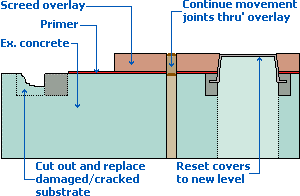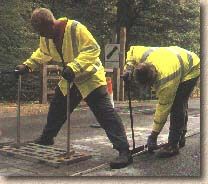Decorative Concretes
This section looks at a few of the other popular decorative finishes for concrete surfaces. Staining and sand-etching are techniques applied to prepared concrete surfaces while the textured overlay method can be used on a concrete or other firm substrate such as tarmacadam/asphalt. Finally, we take a brief look at imprinted bitmac surfaces.
Textured Overlays
Textured overlays consist of a thin screed of a high-strength polymer-modified cement-based material that is coloured, laid over an existing substrate and then textured accordingly. It is similar to the Spray-On stencil system described elsewhere.
Polymer modified cementitious overlay systems, as they are more formally known, are considered in more detail on a separate page.
Again, a clean and structurally sound substrate is essential. An existing concrete should be power-washed and acid-etched to remove all dirt, laitance or other deleterious material. Existing access and drainage covers should be elevated to the new level (3mm below finished surface level) prior to the work commencing, and provision must be made for the extension of any movement joints. Any cracks or damaged sections of the concrete substrate should be cut out and patch-repaired with new concrete or an epoxy resin repair mortar. Any such repairs should be given ample time to cure before covering with the overlay coating.
Once the substrate is prepared, a primer coat is applied to ensure a sound bond between the substrate and the overlay. The overlay powder itself is mixed with a measured quantity of clean water in a mechanical mixer to achieve a smooth, workable yet not 'sloppy' consistency, which is applied immediately to the primed substrate and levelled out by tamping with screeder bars, and working with floats and trowels to the desired level.

Once the overlay screed is in place, it can be left smooth or it may be textured by use of texture mats (as used for PIC), stencils, textured rollers or other decorative tools to create the desired effect.
Colour Staining
Introduction
Staining of concrete surfaces is a relatively new and rapidly developing art within the concrete finishing trade. Although it is hardly known in Britain and Ireland, staining is growing in popularity over in North America and there are several companies now trying to introduce the various technologies into Western Europe. Frankly, we can't see it having a significant impact on the residential driveway/patio market, but there is a small amount of demand from specialist designers and commercial projects.
The overall effect is to produce a mottled, blotchy, organic looking surface that isn't immediately recognisable as concrete. The basic, some might say "limited", palette of colours can be created in a range of intensities, resulting in a surface that has a multi-toned, almost natural appearance. This technique is more commonly used on internal concrete slabs, ie, floors, rather than external slabs such as patios, paths or driveways.
How it works
There are a two main different types of stain used to colour the concrete; chemical staining, such as acid-etch stains, and surface colourisers. There are also some products that purport to be stains but are, actually, surface films, and so are more accurately termed 'paints' rather than 'stains'.
Chemical staining involves the delivery of reactive metallic compounds into the upper surface of the concrete, whereupon they react with the lime content (Calcium Carbonate) resulting in a more or less permanent and irreversible colour change within the concrete. Some rely on an acid to force their way into the concrete (acid-etch staining) while others are water based and simply soak in to the surface, carrying the reactive compounds with them.
Surface colourisers also work by soaking into the upper surface and may be water or solvent based. Rather than reacting chemically with the minerals in the concrete, the stain pigment is deposited in the tiny pores of the slab. Given that there are hundreds of thousands of such pores within each square metre of concrete, this can be a very effective colouring process.
Limitations
Because there are so many variables in the staining procedure, it is impossible to guarantee an exact colour or effect. Not only does the cement content of the concrete have an effect on the final colour, but the sands and gravels used also influence the results, as does the use of any admixtures within the concrete. Other, less obvious factors also impact upon the final appearance; the type and amount of trowelling the concrete received during placement; the time elapsed since the concrete was poured; the starting colour of the slab; the moisture level within the concrete, even the prevailing weather conditions, all have an effect on the finished results.
Consequently, each surface so treated is unique, and as such, it is important that the client is aware of the highly variable results and is not expecting or insisting upon a very definite finished look. Even a test panel cannot predict exactly just what the final appearance will be, and so the client must be prepared to accept a rather unspecific, generic outcome.
Who does it
Although there is a reasonable body of experience with this technique in North America, it has had limited use in Britain and Ireland and consequently, experienced exponents of this art are few and far between. Unfortunately, experience is the key factor in successful use of acid staining, as knowledge of the various effects and familiarity with the processes are essential to the production of a decent-looking finished surface. Contractors with genuine experience of this technique are almost exclusively found in the commercial market, rather than the residential 'drives and patios' market.
Because of the special skills required, selecting a contractor at random from the Paving or Concrete section of the 'phone directories is somewhat hit-and-miss. The suppliers and manufacturers of the staining products are a much better source of leads, as they will know which gangs specialise in this type of work. Contact details for the better suppliers and distributors can be found on the Links page.
How it's done
The concrete to be stained must be clean, sound and free of any contamination. Most stain manufacturers recommend that the slab to be stained is fully cured, that is, at least 28 days old. It may be necessary to 'sand' or 'grind' the surface to ensure a clean surface that will allow the stain to penetrate. All dust from such preparatory work must be removed prior to staining. The surface should also be washed down using clean water and a mild detergent (NOT an acid-based cleaner).
The stain itself can be applied by a brush, or a squeegee, or a sprayer, with different methods of application having different outcomes. Some projects will have several applications of the stain, possibly at different dilutions and over a number of days to bring about a satisfactory look.
When the staining work is declared 'done', the surface is again washed down to remove any chemical residue. Finally, after allowing the surface to dry for 48 hours or so, a suitable sealant is applied.
The range of possibilities for acid staining can be increased by combining with other decorative concrete techniques, such as ...
- dye-coloured concrete
- texturing
- scoring of lines and patterns
- sand-blasting
Sand-blasting
This is another under-utilised technique for improving the finished appearance of a concrete surface. It works best in conjunction with one of the colouring techniques; a pre-coloured slab can be etched to reveal the contrasting concrete colour beneath, or a plain slab can be etched and then selectively stained to emphasise the etching. Sand-blasting should only be undertaken on a fully-cured slab (ie, 28 days or older).
The basic technique consists of masking-off a pattern, design or logo and then using appropriate sand-blasting equipment to etch the desired pattern into the unmasked surface, which may then be further enhanced with, for example, staining. The masking-off is achieved by means of stencils that are pre-cut onto a special adhesive film and supplied in rolls or as single piece items.
The patterns are most commonly selected from an 'off-the-shelf' range of decorative borders and centrepieces although corporate logos, slogans, property names and numbers, or just about any other design can be turned into a stencil of almost any size. The concrete slab is carefully cleaned and marked out with guidelines to assist the accurate positioning of the stencils. Once the stencils are in place, the design is picked out and then sand-blasting commences. Once the etching is complete, the remainder of the stencil is simply peeled away and disposed, while the etched surface can be cleaned and further enhanced with staining, if so desired.

This is definitely not a job for the diy'er. The sand-blasting equipment is cumbersome and not for the faint-hearted and, like most of the other decorative concrete techniques, there is no easy way to correct any errors. Further, there are onerous Health and Safety Regulations governing the use of sand-blasting equipment, and it really is a task best left to professionals.
Imprinted Bitumen
While not actually a technique for decorative concrete, imprinted bitumen compounds have some similarities with imprinted concretes, in that a pattern is 'stamped' into the surface before it sets or cures. However, the imprinted bitumens are used on public highways rather than low-speed decorative areas and residential driveways, and are not suitable for DIY.
The basic technique involves flame-treatment of the existing concrete, bitmac or asphalt surface to remove any deleterious material, and then applying a modified polymeric bitumen-based compound that has been heated to around 200°C in a layer approximately 10-25mm thick, and screeding it to the required level. Before the compound has fully cooled, a pattern is stamped into it with a steel pattern former.
The imprinted surface can be re-opened to traffic in as little as 45 minutes, making it a popular treatment option for highway engineers.

It also comes in a range of colours, allowing the visual demarcation of features such as cycle lanes. The bitumen compound is supplied in pre-packs, ensuring a consistent quality, including satisfactory values for wear, rutting and skid resistance, which is essential for all highway surfacings.
